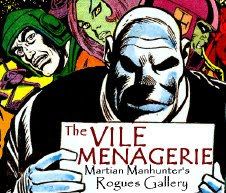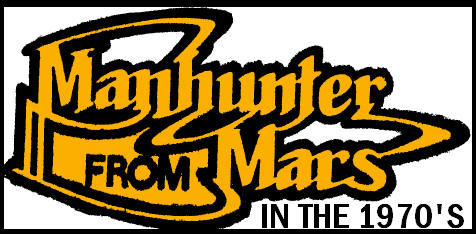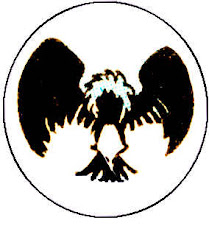Monday, May 5, 2025
JLA/JSA: Virtue and Vice (2003)
Outside the JLA Watchtower on the moon, Superman and Sentinel gaze upon the distant Earth from the frigid blackness of space-- placing the two Golden Age heroes on an equal standing for the only time ever. The Justice Society and their successors, the Justice League, have decided to reinstate an old tradition of the two teams fraternizing on a regular basis, breaking bread in fellowship. However, the twin figureheads of the respective teams maintain a watch, with the Manhunter from Mars breaking in telepathically to direct them toward unrest in Arusha, Tanzania. Detroit-era Leaguer Vixen was already on the scene, but she's backed up by two of the best to repel an assault on President Lex Luthor by Doctor Bedlam of the New Gods. The other combined heroes soon follow suit, with Martian Manhunter continuing to direct their activities.
At JSA Headquarters, J'Onn J'Onzz notes psychic interference that he experienced in East Africa. The heroes begin to get catty with one another. Hostilities erupt. The Martian Marvel begins to lose physical coherence from the constant psychic assault, and is more or less out of the story from there. Seven of the heroes' personalities are so severely warped that their compromise becomes obvious. On page 28, the reveal that they've become possessed by the The Seven Deadly Enemies of Man, archetypes of sin usually confined to the Rock of Eternity by the wizard Shazam. The general population of the globe is also acting irrationally. The tortured Sleuth from Outer Space warns that Luthor is a key factor in this, before being placed in a magical coma by Zatanna and other reinforcements. In an already crowded book, a lot of space is allotted to the second-stringers. Clearly going for a Morrisonian maximalist approach, there's so much going on with so many players in so many locations that it all becomes noisy bullet points instead of the intended spectacle.
Black Canary leads the confrontation of the President in the Oval Office. Along with everything else, the chess pieces carved in the likenesses of the heroes should have been a dead giveaway. Luthor is actually Despero, "Extraterrestrial dictator. One of the League's first adversaries." Mentally freezing the heroes in place, there's a truly tortured backstory involving a swift overview of Despero history, including his relatively recent final discorporation by the Earth Angel incarnation of Supergirl. His spirit ended up in whatever dimension the JSA villain Johnny Sorrow hails from, and their combined psychic power crossed dimensions to posses Dr. Bedlam on Apokolips. While Despero was being smuggled into Luthor, Sorrow was handling Shazam and freeing the Enemies. It goes on and on for pages, but at least in the end, Despero turns a U.S. flag into a cape to mirror that time he accidentally did the U.N. one similar. He did the thing! We love when they do the thing! I mean, I do here, but still. The least among them, Green Arrow, uses gas (not from chili) to free the heroes to escape, hunted by third eye blinded U.S. troops with orders to kill.
Eventually, the heroes trick the Gluttony-possessed Captain Marvel to call down his lighting, with Billy Batson exorcised of the Sin. That same lighting flows back to Shazam, reviving him so that he can recapture the other Deadly Enemies. The JLA, JSA, and reserves combine their might. Despero makes a great showing by surviving a quantum leaping Captain Atom, having the Rock of Eternity almost land on him, and then got a faceful of an unmasked Johnny Sorrow. He also slammed Superman and Captain Marvel's heads together at one point. A grateful Luthor was imposed upon to replace the destroyed old stone JSA headquarters with a shiny new one.
"Virtue and Vice" was by David S. Goyer & Geoff Johns and Carlos Pacheco & Jesus Merino. Technically, this book came out in 2002, after my retailing days, and once the bloom was well off the JLA rose-- about halfway through the Kelly/Mahnke run. The premiere hardcover cost $24.95, which in adjusted dollars would be $44.35, and was the equivalent of over 11 standard contemporaneous comics. If you want to split hairs, it was 96 pages of original content, roughly 4 & a third comics, while that same month's Green Arrow: The Archer's Quest reprinted six comics for five bucks less. All I know is that it felt egregious, and then it took nearly a year to come out on softcover for $17.95 ($31.20 in 2025.) My memory of this time period is really hazy, so I may have been between brick & mortars getting some pitiful barely-covers-sales-tax discount, stopping by once or twice a month, barely keeping a toe in the industry. I may have swallowed hard and bought the softcover new, but probably got it as a backlist later, and thoroughly resented it. I kept buying JLA and related projects until Infinite Crisis, but I only occasionally read it, and the strip-mining of that brand put me off. It took until Fanholes did a podcast on it for this year's inaugural #JSApril social media event that I finally sat down to read the thing nearly a quarter century late. In fact, I figured I might just harvest some extra eyes and do this post last week, but I thought it would be uncool to bite F@nholes' action, and also I'd be a Debbie Downer about it, besides.
The late Carlos Pacheco was a fantastic artist whose detailed work did not lend itself to long runs, and I mostly admired from afar since those runs were typically on books I didn't follow. For instance, he did four issues of The Flash that one year I tried hard to get into Mark Waid's run, and that's the longest streak I ever had buying Pacheco comics. I'd say his strongest influence was Alan Davis, but he had flashy Image qualities, including some particular anatomical quirks, that made him feel more modern. The Spanish scene vibes were also there, not that I could articulate exactly what that means practically. So, I enjoyed his stuff, and think he was particularly great on Fantastic Four... just not to the degree that he could get me to buy a book just for his art. I like looking at this book, and it makes me wish he'd had a proper run on JLA, but it doesn't overcome what a shallow and convoluted mess this story was. Likewise, this is one of the best renditions of Despero ever, his chief representation online for years afterward-- but probably not in my top five, personally. Kind of rubbery, not that menacing, and I'd swear Ordway inked him on one panel. I think Johns has love for him, and I preferred his second pass (with blessedly more Martian Manhunter) in one of the last JLA arcs. Besides J'Onn's lackluster use here, the Alien Atlas is maybe the character Pacheco has the worst handle on here. He won't commit to the beetle-brow, so his head is just lumpy like a potato. He's got a resting Grinch face, and the classic costume isn't rendered very flattering. Alan Davis has a much better take, including tweaking the suit to his style. I do really like Pacheco's Atom & Hawkman, but Wonder Woman's breast and thing are out of control. Goyer/Johns also give us one of the more obnoxious Plastic Man takes of the dire Ace Ventura period of his characterization, which is painful.
Subscribe to:
Post Comments (Atom)


































2 comments:
I remember being disappointed with J'Onn being out of the story so soon, I kind of didn't care after that. Do you have any thoughts on the absolute book?
I'm glad it's doing well-- proportionately probably the most commercially success Martian Manhunter series, ever. I'm also glad that they're taking chances with the project. I may buy and read the first trade. I'm not convinced that it has much of anything to do with my interests in the character, though.
Post a Comment